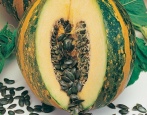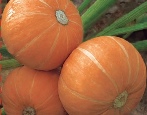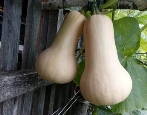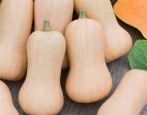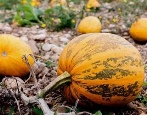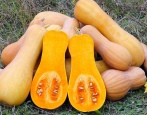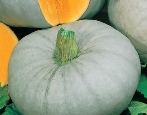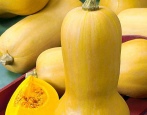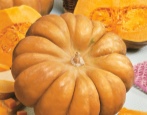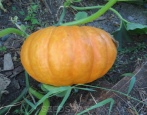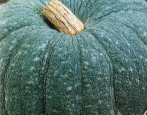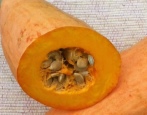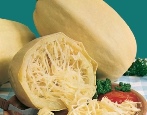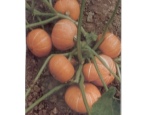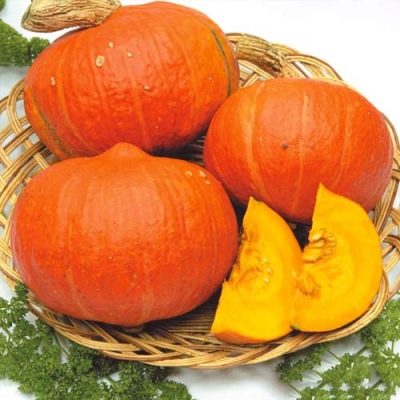
- Lash length, m: 4-5
- Weight, kg: 1-1,5
- Coloration: red-orange
- Color of the pulp: orange
- Pulp (consistency): dense and starchy
- Taste: pronounced nutty flavor
- Taste qualities: excellent
- Ripening terms: early maturing
- The period from germination to harvest: 95 days
- Appointment: universal
Pumpkin is a popular vegetable that is included in traditional dishes around the world. That is why scientists are working on the creation of pumpkin species that can grow in different climatic zones, bring good harvests, without requiring complex agricultural technology. These include the pumpkin hybrid Hazelnut.
Description of the variety
Pumpkin Hazelnut is a powerful plant, characterized by long lashes that grow up to 4-5 meters, moderate thickening of bright green leaves, giving splendor to the pumpkin bush, a developed root system that goes into the ground to a depth of 4 meters, and a noticeable edge of the shoots.
During the flowering period, large and bright orange inflorescences are formed on the bushes, emitting a pleasant aroma. On average, 4 pumpkins are formed and ripen on one plant, but up to 5-7 specimens grow on some bushes.
Characteristics of the appearance of plants and fruits
Pumpkin Hazelnut stands out among its congeners for its attractive appearance. Specimens ripen even and neat. The hybrid belongs to the medium-fruited varieties. The average weight of a vegetable is 1-1.5 kg. The shape of the fruit is round, with a prominent tip and a slightly elongated base. Outwardly, the pumpkin resembles a hazelnut. The surface of the vegetable is smooth, firm, uniform red-orange color, diluted with pale stripes. The bark of the pumpkin is quite thick, so the harvested vegetables are easy to transport. There are very few seeds in the pulp, they are flat and small.
In addition to high transportability, the hybrid is endowed with good keeping quality - 6-7 months. During the storage period, the taste of the vegetable only intensifies, becomes more saturated.
Purpose and taste
Hazelnut attracts not only with its external data, but also with its taste. The dark orange pulp has a dense, fleshy, tender, moderately juicy consistency without fibrillation and voids. The pumpkin has a harmonious taste: moderate sweetness goes well with nutmeg notes and a nutty aftertaste. It is also worth noting the increased starch content in pumpkin pulp.
Harvested vegetables are ideal for preparing cereals, mashed soups, puddings, casseroles, pie fillings, and pumpkin can be baked and added to salads.
Ripening terms
Hazelnut is a hybrid of early ripening. The growing season of a vegetable lasts 95-100 days. Fruit germination and ripening are friendly. The massive harvest takes place in August-September. The ripening of the pumpkin is evidenced by yellowed foliage, a dense and tough stalk, as well as a hard bark of the fruit.
Yield
The productivity of this pumpkin species is good. On average, one plant produces 5-7 kg of fleshy specimens.
Growing and care
The vegetable is cultivated by the seedling and seed method. In open ground, seeds are sown in the second half of May, when the soil and air are warm enough. The seeds are preliminarily disinfected, dried and sown in pre-prepared pits 5-10 cm deep. The optimal scheme for planting is considered to be a scheme of 70x100 cm.It is recommended to cover the planted bed with a film, which will accelerate the germination processes, and also protect against unexpected cold snaps at night. The film is shot in June-July.
Sowing for seedlings is carried out at the end of April, and then the matured bushes are transplanted to the garden bed.As a rule, the transplant procedure is carried out in May-June (depending on the climatic characteristics of the region), after 30 days. Planting is carried out in peat cups, where several seeds are placed. Good precursors for pumpkin are peas, beets, beans, cabbage, beans, and peanuts.
Exotic pumpkin care is standard: watering every 6-10 days (as soon as the fruits begin to turn yellow, irrigation stops), top dressing throughout the growing season (3-4 times), loosening the soil after each watering, weeding, which helps to remove weeds, obligatory pinching , otherwise all forces will be spent on the formation of greenery, thinning of foliage, prevention of diseases and insect infestations.
Requirements for soil and climatic conditions
Pumpkin Hazelnut is an unpretentious culture that can grow in any soil, but it is most comfortable for a vegetable to develop in light, fertile, moist and breathable soils with neutral acidity.
Melons are planted in sunny areas, where it is sufficiently light and warm. Despite the stress resistance, the pumpkin needs constant sun, moderate moisture, protection from the gusty cold wind.
Disease and pest resistance
The culture's immunity is average, so pumpkin is sometimes subject to diseases such as powdery mildew, anthracnose, black mold and ascochitosis. Dangerous among the pests attacking the plant is aphid, which will help to get rid of it by spraying with insecticides.
